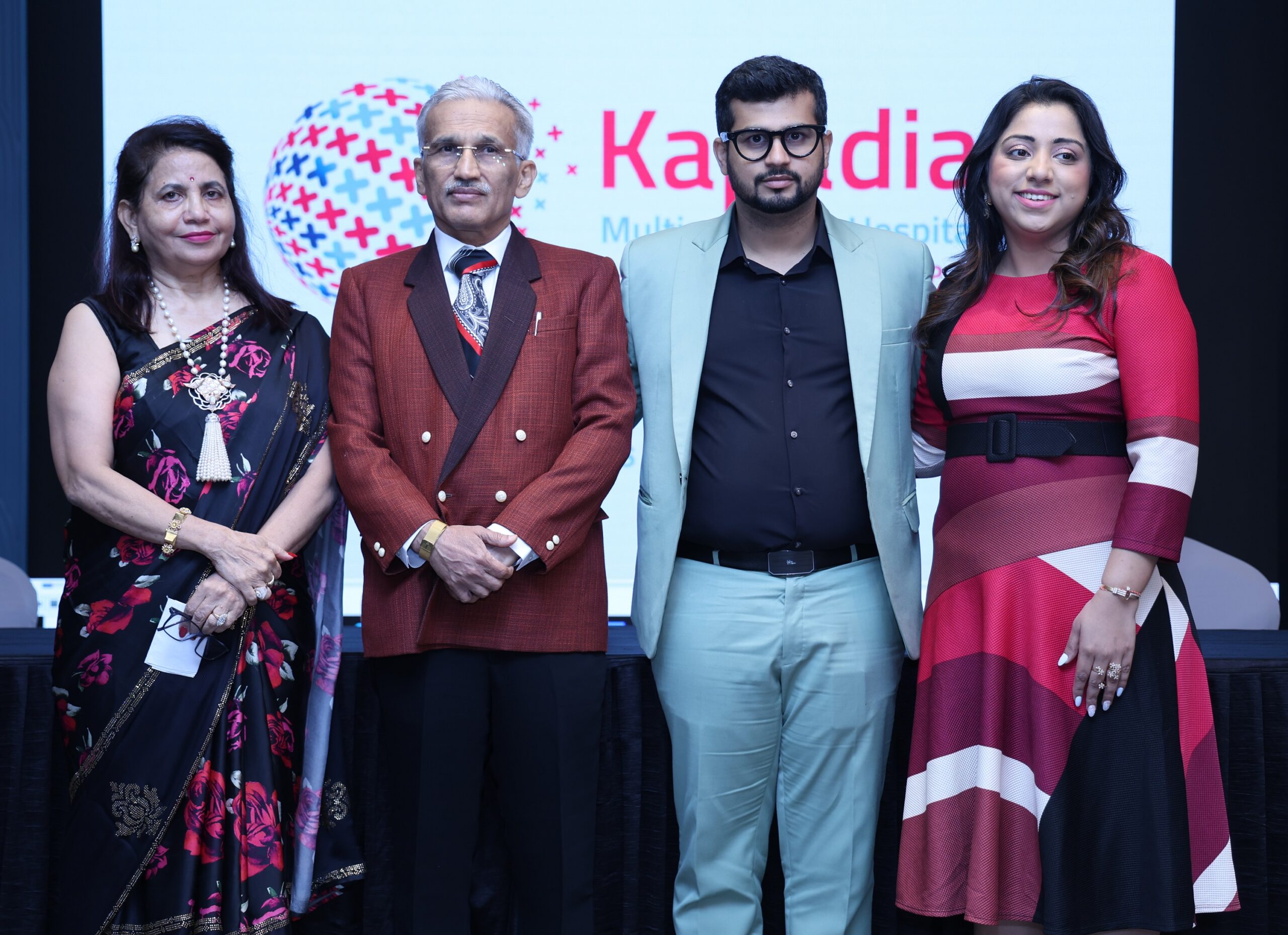MSN Realty Unveils its inaugural project: ‘ONE by MSN’ – A Landmark in Luxury Living at Neopolis
Mumbai / Hyderabad, April 19, 2025 – MSN Realty has announced the launch of its flagship residential project, ‘One by MSN’, marking the company’s debut in the luxury real estate segment. Located in Hyderabad’s rapidly evolving hub of Neopolis, Kokapet, this one-of-a-kind development is spread across 7.7 acres. The project features five elegantly designed towers rising up to 55 floors, offering 655 exclusive residences ranging from 5,250 to 7,460 sq. ft. This launch marks a defining milestone for MSN Realty – the real estate vertical of the diversified MSN Group, known for its legacy of trust and excellence across sectors.

With a planned investment of ₹ 2,750 Cr, ‘One by MSN’ is not just a flagship launch but the foundation of MSN Realty’s larger vision to develop over 20 million sq. ft. across Hyderabad in the next five years. Backed by the financial strength and credibility of the MSN Group, the 4 million sq. ft. project reflects a long-term commitment to reshaping urban living through integrated, high-value developments that blend thoughtful design with modern infrastructure.
The project embodies the philosophy of Panchtatva – the five natural elements of Earth, Water, Fire, Air, and Sky and reflects this in its design approach. ‘One by MSN’ is planned to align with principles of space, light, and harmony with architecture that prioritizes openness, natural ventilation, and visual connection to the outdoors. With views of Osman Sagar Lake, the project includes features such as private lobbies, dual access, and layouts designed for seamless indoor-outdoor transitions.
The development includes 1.8 lakh sq. ft. of amenities, spanning the clubhouse, podium, and a Skypark, equipped with three swimming pools (including a temperature-controlled indoor pool and an infinity pool), along with dedicated recreational and wellness areas such as a yoga deck, sky cinema, aqua gym, and multipurpose lawns. In addition to community spaces, the project integrates sports infrastructure including courts for badminton, squash, pickleball and paddleball, in addition to a bowling alley, as well as simulators for cricket, football, and golf – all supported by a forward-looking approach that brings together smart technologies, energy-efficient systems, and seamless digital integration to elevate everyday living.
Speaking on the occasion, Dr. MSN Reddy, Founder, Chairman & Managing Director of MSN Group, said, “With ‘One by MSN’, we are entering the real estate sector with a clear focus on thoughtful design and long-term value creation. Our aim is to build spaces that are aligned with evolving urban needs while being rooted in quality and functionality. We’re proud to begin this journey from our home city, Hyderabad, and look forward to shaping the future skyline of India with the same passion and purpose that define MSN Group.”
Ben Böhmer to Showcase ‘Bloom’ in Mumbai
India, 17th April 2025 – Ben Böhmer, the award winning Berlin-based DJ and producer celebrated for his emotive soundscapes, is set to deliver a bespoke performance at Mumbai’s Dome SVP Stadium on May 8, 2025. This one-night-only immersive event, a collaboration between Sound Simplify, Team Innovation Spacebound, and Dome, marks Böhmer’s sophomore return to Mumbai since his ‘Breathing’ Tour. After his multi-sensory ‘Bloom’ Tour performances in Kolkata, New Delhi, Hyderabad and Goa last year, fans can anticipate a deeply resonant experience.
Ben Böhmer has garnered international acclaim for his ability to seamlessly blend deep house, progressive elements and poignant melodies, creating a sonic tapestry that resonates deeply with audiences worldwide. A composer and producer dedicated to bringing fresh ideas to life, Bohmer has spent over a decade perfecting his craft, channelling profound emotions through his music. His groundbreaking debut album, ‘Breathing’, delved into themes of grief, while its 2021 follow-up, ‘Begin Again’, explored the pain of separation. With nearly a billion streams and over 200 performances in 2022, Bohmer achieved remarkable success, yet found himself disconnected from his artistic vision. His latest critically lauded third album, ‘Bloom’, signifies a bold reset—a confident return to his improvisational roots and true creative aspirations. ‘Bloom’ captures Ben’s artistic evolution, embodying his joyful embrace of innovation and relentless passion for creation.
Touring in support of ‘Bloom’, which was heralded as a demonstration of all the depth, lushness and absolute feeling the German producer is a master of, the tour will feature an upgrade to Ben’s show, which now includes his instrument of choice, the piano, returning Ben to his improvisational roots as an artist and composer. The setlist will include tracks such as ‘Martin’, ‘Rust’, ‘Beyond Beliefs’, ‘Breathing’, ‘Wall Of Strings’, ‘Evermore’, ‘The Space In Between’, ‘Rain’, ‘Father Ocean (Ben Bohmer Remix)’, ‘Best Life’ and ‘Faithless’.
Ben Böhmer states, “My previous experiences performing in India have been truly special. The energy and passion of the crowds is incredible, and I’m thrilled to be returning to Mumbai after two years to share my latest sounds and create another memorable night together.”
Mohit Agarwal, Founder, Sound Simplify states, “We’re incredibly excited to bring Ben Böhmer back to India. His music transcends genres, offering fans an immersive experience that resonates on a deeply emotional level. This bespoke performance will be an unforgettable night.”
Mohit Bijlani, Co- Founder, Team Innovation states, “Ben Böhmer’s artistry represents a sophisticated and deeply emotive corner of electronic music that has widely resonated with the Indian audiences during his previous visits. We are delighted to welcome him back to Mumbai, further solidifying his connection with his fans here.”
Karan Singh, CEO, Spacebound states, “Ben Böhmer’s ‘Bloom’ tour represents a new chapter in his artistic journey, and we’re thrilled to be a part of bringing that vision to Mumbai. His dedication to innovation and creating meaningful sonic landscapes aligns perfectly with our mission to deliver exceptional experiences to Indian fans.”
Mazhar Nadiadwala, CEO, Dome states, “The SVP Stadium is excited to host Ben Böhmer, an artist known for his emotive soundscapes and immersive performances. We are ready to welcome fans for a night of unforgettable music, showcasing the venue’s capability to create memorable experiences. “
Attendees can anticipate a meticulously crafted set that showcases Böhmer’s signature blend of introspective melodies and driving rhythms, all within the state-of-the-art acoustics and ambiance of the performance venue. Building on the success of his prior appearances, this event is poised to be a highlight of Mumbai’s spring cultural calendar, offering a sanctuary of sound for those seeking a more nuanced and emotionally engaging electronic music experience.
Kapadia Hospital Joins AI Surgery Revolution Hailed by PM Modi
Mumbai, April 3rd, 2025: Kapadia Hospital has enhanced its orthopaedic care by installing MISSO, an advanced robotic system designed in India for knee replacement surgeries. This being the first installation in Mumbai, MISSO combines smart technology with surgical expertise to deliver high precision and faster recovery, making quality healthcare more accessible.

MISSO, designed and made in India, uses advanced computing and real-time data to map surgeries in 3D, guiding surgeons for precise cuts and implant placement. Its six-joint robotic arm, tracking camera, and safety features enable real-time adjustments, ensuring stable, natural joint movement. With a minimally invasive approach, it reduces tissue damage, bleeding, and recovery time, helping patients return to daily life faster. Aligned with Aatmanirbhar Bharat, MISSO showcases India’s innovation in medical technology, making world-class robotic surgery more accessible.
Dr. Rahul Modi, Robotic Knee and Shoulder Surgeon, Kapadia Hospital, said, “MISSO redefines orthopaedic surgery in India by combining cutting-edge AI with surgical expertise. As an indigenous robotic system, it enhances precision, minimizes recovery time, and improves surgical outcomes, allowing patients to regain mobility faster and with greater comfort. This breakthrough in medical technology raises the standard of patient care, making advanced orthopaedic treatment more effective and accessible.”
Dr. Rajan Modi, Founder, Owner & Consultant Laparoscopic Surgeon, Kapadia Hospital, said, “MISSO’s versatility sets it apart, enabling us to perform a wide range of orthopaedic procedures with exceptional precision. Unlike conventional robotic systems, it streamlines surgical workflows and optimizes hospital resources by eliminating the need for multiple platforms. With the introduction of daycare knee replacement surgeries, we can now offer faster recovery, greater efficiency, and improved accessibility, redefining patient care standards.
Nikhil Kamath’s Gruhas Leads INR 12.5 Cr Investment in LehLah
Mumbai, April 2, 2025: LehLah, a creator-led content commerce startup, has raised INR 12.5 cr in its seed funding round, led by Gruhas, a company co-founded by Nikhil Kamath and Abhijeet Pai. This investment highlights the growing appeal and market presence of LehLah. The funds will be utilised for product development, increasing brand visibility, and expanding the team.
Commenting on the funding, Nikhil Kamath said, “Shopping today isn’t just about products—it’s about trust, influence, and community. People don’t want to be sold to; they want recommendations from those they relate to. The future of commerce may belong to platforms that empower individuals to monetize their influence while making discovery and purchasing seamless. Only time will truly tell.”
Ashna Ruia, Founder, LehLah stated, “We are excited to embark on this new chapter with the backing of Gruhas, who share our vision for transforming the creator economy. This support enables us to amplify our mission of empowering creators to build thriving businesses around their passions. As we continue to innovate and scale, we are inspired by the opportunity to redefine the intersection of creativity, commerce, and community, with key partners like Nikhil Kamath by our side.”
LehLah is a content commerce platform that empowers creators to monetise their influence by sharing affiliate links for curated product recommendations. It bridges the gap between creators and brand partners, turning authentic content into a powerful revenue stream. By offering a seamless shopping experience for followers, LehLah drives sales and boosts conversions for brands.
Since its inception, LehLah has experienced rapid growth, partnering with leading e-commerce platforms like Myntra, Meesho, Flipkart, and Nykaa, as well as prominent D2C brands like Libas and Foxtale. This collaboration has contributed to a 46% month-on-month increase in GMV and enabled over 700,000 content pieces through its extensive creator network.
Gen Z Sisters Launch Muze, Mumbai’s New Euro-Asian Hotspot
Mumbai, 21 March 2025: Who needs another predictable pasta or sushi roll when you can have gochujang risotto with seafood or carbonara udon? Verdant Entertainment Pvt Ltd has today announced the launch of Muze, a Euro-Asian fusion dining experience by Gen Z sisters Saloni and Anannya. Located in Khar West, this 2,900 sq. ft. space with 100 seats is their most personal venture yet—a love letter to the cuisines, cultures, and design aesthetics that have shaped their experiences from childhood.
Drawing from their travels, the sisters have crafted a space where Art Deco meets bold Asian aesthetics like animal prints, while the menu balances unexpected flavors where familiar dishes take on bold new identities. Carbonara sheds its pasta roots and finds a new home in silky udon noodles. Muze is a place where risotto isn’t just a risotto—it’s infused with the depth of gochujang and topped with fresh seafood. Even a pizza refuses to play by the rules, with fiery sambal prawns and a peppery rocket leaf finish. And for dessert? A Vietnamese tiramisu that brings the richness of condensed milk coffee into the folds of a classic Italian treat.
“We wanted Muze to be a reflection of our travels—each dish carries a memory, a place, a moment that stayed with us,” says Saloni Shelar, Founder Verdant Entertainment Pvt Ltd. “Whether it’s the Carbonara Udon that reminds us of summers in Tokyo or the Lotus Salad inspired by the vibrant night markets of Vietnam, our menu is a passport to flavors we love, reimagined in ways that excite.”
Leading the kitchen is Head Chef Thevar Chandrahasan Pandian (formerly Indigo Fine Dine, Sassy Teaspoon, and Isabella Tapas Bar), whose culinary approach balances innovation with deep respect for tradition. With a focus on refined techniques and unexpected pairings, he transforms ingredients into dishes that are both playful and deeply satisfying.
Muze’s cocktail menu is a bold reflection of its playful yet refined approach to Euro-Asian flavors. Signature drinks like Muze di Gara—a vibrant fusion of white rum, pineapple oleo, and pickled ginger brine—deliver a unique twist on tropical freshness. The Muze Style Negroni reinvents the classic with a coconut fat-wash Campari, homemade pandan liqueur, and gin, adding a silky, aromatic depth. Meanwhile, the intriguing Muze Sa-Bi blends gin with homemade galangal syrup and a touch of wasabi for an unexpected kick.
Anannya, Founder, Verdant Entertainment Pvt Ltd, shared, “Mumbai’s dining scene is constantly evolving, and we wanted to create something that feels fresh and exciting while still being welcoming. MUZE is our tribute to the cities that have inspired us, and we can’t wait to share it with our guests.”
Designed by Designworkx, Muze’s interiors channel the energy of discovery, blending the glamour of the Roaring Twenties with bold Asian aesthetics. Deep jewel tones, striking geometric patterns, and playful touches like flamingo and tiger motifs bring the space to life. You notice the radical lines and geometry referencing the 1920s European flapper girl era in the elevated diners, while the Art Deco influence extends beyond the interiors to the plating as well. Ambient lighting and layered textures create a balance of grandeur and warmth, mirroring the menu’s fusion of familiar comforts with bold new identities.
Muze is now welcoming guests eager for a dining experience that rewrites the rules. With flavors without borders, cocktails that surprise, and an ambiance that invites adventure, this is not just a restaurant—it’s a journey.
WLSA 2025 Winpe Marks Five Years of Championing Diversity in PE-VC
Mumbai, 11th March 2025: Marking five years of championing gender diversity in private equity (PE-VC) and venture capital, Winpe, a gender diversity-focused not-for-profit platform, is all set to host the third edition of its Winpe Leadership Summit and Awards. The event will take place on 20th March 2025 at Taj Lands End, Mumbai.
At a time when diversity commitments in global investing are being questioned, WLSA 2025 stands as a timely and necessary counterpoint. With a strong track record of impactful programs, WLSA 2025 will showcase how integrating DEI with financial performance is shaping the future of investing. As the PE-VC industry evolves, diversity is no longer just a moral imperative—it’s a business advantage. In this dynamic landscape, WLSA 2025 will build on the success of its two previous editions, which collectively saw over 850 attendees, 275 firms, and 100 speakers. This year, the summit will feature insightful discussions on global economic trends, business scaling, and the evolving PE-VC landscape, highlighting the role of diversity in driving sustainable success.

At the heart of the event are the Winpe Leadership Awards, recognising firms and individuals across 10 categories for their commitment to diversity, equity, and inclusion (DEI). These awards uniquely blend financial performance with DEI progress, reinforcing how inclusive leadership fosters long-term industry growth.
“Over the past five years, Winpe has worked relentlessly to turn conversations on diversity into concrete action. While women-led startups in India raised over $930 million in 2024—a remarkable 94% YoY surge—these numbers are just the beginning. True impact lies in sustained industry-wide commitment to inclusion, where diverse leadership is not an exception but the norm. With WLSA 2025, we aim to set new benchmarks for diversity in investing, ensuring that equitable representation becomes a fundamental driver of financial success,” said Nupur Garg, Founder, Winpe.
India ranked 129th out of 146 countries in the World Economic Forum’s Global Gender Gap Report 2024, underscoring the urgency for stronger DEI efforts across sectors. With WLSA 2025, Winpe is not just sparking conversations but driving measurable change. By bringing together thought leaders, investors, and entrepreneurs, the event seeks to shape a more inclusive, forward-looking investment landscape—where diversity is embedded in decision-making, not just discussed as an aspiration
Handpickd turns EBITDA positive in Gurugram, enters Bangalore
Gurugram/Bangalore, March 10, 2025: Handpickd, India’s first match-making platform for fruits and vegetables, has turned EBITDA positive in Gurugram and has entered into Bangalore. Launched in Gurugram in April 2024 by Anant Goel of Milkbasket with Nitin and Sahil (also ex-Milkbasket), Handpickd enables consumers to buy ‘any quantity of any quality’ of fresh produce as per their personal preference, akin to offline buying and hence a favorite of consumer households in Gurugram.
Anant Goel, who previously co-founded Milkbasket, has been instrumental in disrupting the online grocery space with unique consumer insights and creating a one-of-a-kind supply chain to cater to those specific consumer needs. What Milkbasket did for daily needs like milk, bread, and butter, Handpickd is doing for fruits & vegetables with its zero inventory and tech-driven match-making model.
“Our entry into Bangalore is a strategic step in scaling Handpickd’s match-making platform to new markets,” said Anant Goel, Founder, Handpickd. “We hypothesised that we do not know what is a good quality for a given family. Every family is unique, and so is their F&V. They tell us what they like, we match-make and deliver exactly that to them! And we now know that we can do it at scale and profitably. Our advanced technology, processes, and unique learnings from every order we deliver are our core differentiators, and with every order, we just keep getting better at it.”
“Customers, on average, spend around ₹4,000 monthly on buying fruits and vegetables from Handpickd, which is ~10x of what they spend on any quick commerce channel. It’s 5x of traditional e-grocers. For the first time, the online spend on fresh produce for a family has exceeded that of offline,” he added.
The expansion comes after the company’s successful operations in Gurugram, where it has effectively captured the fresh wallet share of consumers like no other platform has been able to till date. Expansion into Bangalore is an early attempt to further refine its supply chain and discover any shortcomings that might have escaped the founding team’s attention in Gurugram.
The company is betting big on its ‘match-making’ system, where families get handpicked fruits and vegetables specific to their family needs within 7-8 hours of harvest. The zero inventory model ensures that there is no dump after the sales cycle and hence yielding into profitable operations even at a small scale within a short span of launch.
Looking ahead, Handpickd plans to expand its footprint across key Indian cities, targeting 30 new micro-markets by the end of 2025. The company is betting on technology-driven solutions to drive efficiencies, cut down supply chain wastage, and cater to the evolving preferences of urban consumers.
Civis Hosts 2nd Edition of Public Consultation Awards CIPCA 2025
New Delhi, India, March 7 – Civis, supported by Rohini Nilekani Philanthropies, Indian School of Public Policy, and Shri Vinay Toshniwal Memorial Trust, hosted the 2nd edition of Civis’ Public Consultation Awards (CIPCA 2025) on March 5, 2025. The initiative honors ministries, state governments, and statutory bodies for their exemplary efforts in conducting democratic, transparent, and inclusive public consultations in lawmaking. Bringing together luminaries from public administration, governance, and policy-making, CIPCA 2025 aims to foster discourse on participatory governance and highlight exemplary public consultations that have facilitated meaningful citizen engagement in the lawmaking process.
The event witnessed participation of distinguished experts from governance and policy research, including, Dr. K. P. Krishnan, Former Secretary, Ministry of Skill Development & Entrepreneurship; Shri P. K. Malhotra, Former Secretary, Ministry of Law and Justice; Dr. Deepak Mohanty, Chairman, PFRDA; Shri Adil Zainulbhai, Chairperson, Capacity Building Commission, and Smt. Snehlata Shrivastava, Former Secretary General, Lok Sabha and Jury Member, Civis’ Public Consultation Awards among others.
Speaking at the event, Antaraa Vasudev, Founder, Civis, emphasized the critical role of public consultations in shaping effective governance “In 2025, the awards have recorded a 60.8% increase in public consultations, not just in number, but our consultations have scored higher on quality indicators as well – for example 71.4% consultations were available in more than one language. This underscores the importance of creating a robust methodology to measure consultations – and the importance of putting the spotlight on best practices – both of which Civis’ Public Consultation Awards aim to do.”
In the category of ‘Best Consultation: Ministry’, the Ministry of Environment, Forest and Climate Change stood as winner for the public consultation on Draft Hazardous and Other Wastes (Management and Transboundary Movement) Amendment Rules, 2023.
In the category of ‘Best Consultation: State’, the Government of Kerala stood as winner for the public consultation on Draft Kerala IT Policy 2023.
In the category of ‘Best Consultation: Statutory Body’, the Central Electricity Regulatory Commission (CERC) stood as winner for the public consultation on Draft Central Electricity Regulatory Commission (Terms and Conditions of Tariff) Regulations, 2024.
In the category of ‘Special Mention for Citizen Government Engagement, the Food Safety and Standards Authority India (FSSAI) stood as winner for the public consultation on Draft Food Safety and Standards (Alcoholic Beverages) Amendment Regulations, 2023.
In the category of ‘Special Mention for Responsive Governance’, we have two winners which are The Competition Commission of India (CCI) for the public consultation on Draft CCI (Lesser Penalty)
Regulations 2023 and The Pension Fund Regulatory and Development Authority (PFRDA) for the public consultation on Draft Amendments to the PFRDA (Redressal of Subscriber Grievance) Regulations, 2015.
Over the past decade, the number of policies and laws undergoing public consultation in India has increased by 2112.5% since 2014. While this growth is commendable, ensuring the quality and inclusiveness of these consultations remains a priority. Civis launched the Public Consultation Awards in 2024 to evaluate the effectiveness of public consultations across ten key metrics. These metrics include the quality of the consultation document (measured by the presence of factors like the justification for the new policy, impact assessment, readability), extent of outreach conducted, duration for which the policy was open to feedback, presence of translations and transparency concerning responses received.
These metrics have been developed using internationally recognized frameworks, including India’s Pre-Legislative Consultation Policy, OECD guidelines, and the UN Public Consultation Index, in collaboration with a panel of experts including Dr. M. S. Sahoo, Founding Chairperson, Insolvency and Bankruptcy Board of India (IBBI); Dr. Ajay Shah, Senior Research Fellow and Co-founder, XKDR Forum; Smt. Snehalata Srivastava, Former Secretary General, Lok Sabha and TrustBridge Rule of Law Foundation.




